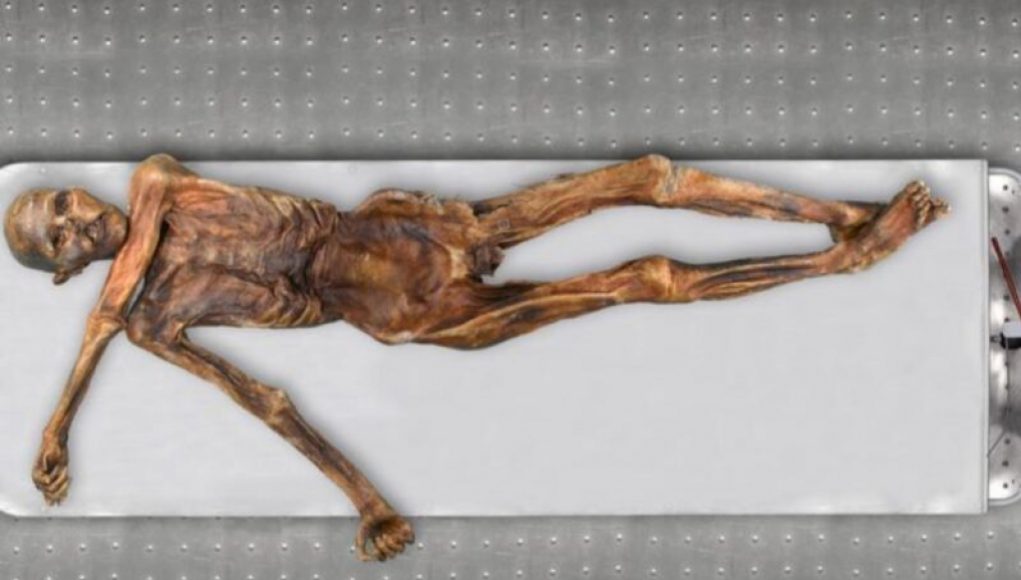In 1991, a group of hikers made a chilling discovery in the Alps. They stumbled upon the mummified remains of Ötzi the Iceman, emerging from a melting glacier. The arrowhead lodged in his shoulder suggested a violent end to his life. In 2012, scientists sequenced Ötzi’s genome, revealing fascinating details about his physical traits and ancestry. It was determined that he had brown eyes, type O blood, blocked arteries, Lyme disease, and lactose intolerance. Additionally, Ötzi was found to be descended from Steppe Herders who migrated from Eastern Europe to the region nearly 5,000 years ago.
However, a recent study published in the journal Cell Genomics challenges these previous findings. The researchers suggest that Ötzi actually shares more genetic ancestry with early farmers from Anatolia, who migrated 8,000 years ago. They argue that the initial genetic analysis was tainted by modern DNA contamination. Using advanced sequencing technology, the scientists paint a more accurate picture of Ötzi’s appearance and genetic traits. Surprisingly, it is now believed that his skin was darker than previously thought, and he may have been bald or nearly bald at the time of his death.
Over the past three decades, archaeologists have meticulously studied Ötzi and the wealth of information he brought with him from the Copper Age. His genome, skeleton, last meals, tattoos, and gut microbes have all been examined. In 2016, DNA sequencing revealed that Ötzi’s clothing was primarily made from domesticated animals such as cattle, goats, and sheep. However, his hat was crafted from brown bear hide, and his quiver was made from a wild roe deer.
Advertisement
In 2018, researchers delved deeper into Ötzi’s tools, shedding light on his lifestyle, final days, and the trade networks connecting Alpine communities. They also analyzed the remnants of his last meal, discovering that he enjoyed a high-fat diet consisting of red deer, wild goat, and whole-grain einkorn wheat. However, it is possible that he unintentionally consumed toxic ferns.
The prevailing theory is that Ötzi fled from the valley after being attacked and froze to death in the gully where his mummified remains were found. The ice quickly buried his body and belongings, preserving them for over 5,300 years under a moving glacier. The gully provided protection from the glacier, preventing damage to the remains.
However, in 2022, scientists proposed an alternative scenario. They suggest that Ötzi actually died elsewhere on the mountain and that natural environmental changes gradually transported his remains into the gully. Furthermore, they believe that for the first 1,500 years after his death, Ötzi’s body likely thawed and refroze multiple times. This revelation opens up the possibility of discovering more ice mummies in the future, as extraordinary circumstances are not necessary for preservation similar to Ötzi’s.
In an exciting new discovery, researchers have released remarkable new findings based on a genetic analysis of the remains of Ötzi the Iceman, an ancient man found frozen in the Ötztal Alps on the border of Austria and Italy in 1991. Ötzi’s amazingly preserved body has provided a wealth of insight into the culture and lifestyle of humans who lived during the Copper Age more than 5,300 years ago, and the latest genetic analysis has offered even more surprising and unexpected details.
The study, led by scientists at the European Academy of Bolzano/Bozen, used new genetic testing techniques to analyze the full genome of Ötzi. Their research revealed that he had brown eyes and was lactose-intolerant, as well as providing details of his ancestry. According to the team’s analysis, Ötzi was closely related to modern-day Italian populations, though his mitochondrial DNA indicated a link with people living in the area near the Black Sea.
The team also evaluated his Y-chromosome and were able to determine that Ötzi was a member of the G2a haplogroup, a rare genetic lineage that is now virtually extinct. This finding offers evidence of population movements among Ice Age hunter-gatherers and suggests that the G2a haplogroup was more widespread in the region around 6,000 years ago than it is today.
In addition, the researchers discovered that Ötzi was infected with a type of Helicobacter pylori bacteria that is not often seen in modern people. This suggests that pathogenic bacteria were more widespread in the past than previously thought.
The genetic analysis of Ötzi’s remains provides yet another unique window into the lives of people who lived during the Copper Age. This latest discovery has rewritten the history books and revealed previously unknown insights about the past as well as about the current human population.




















